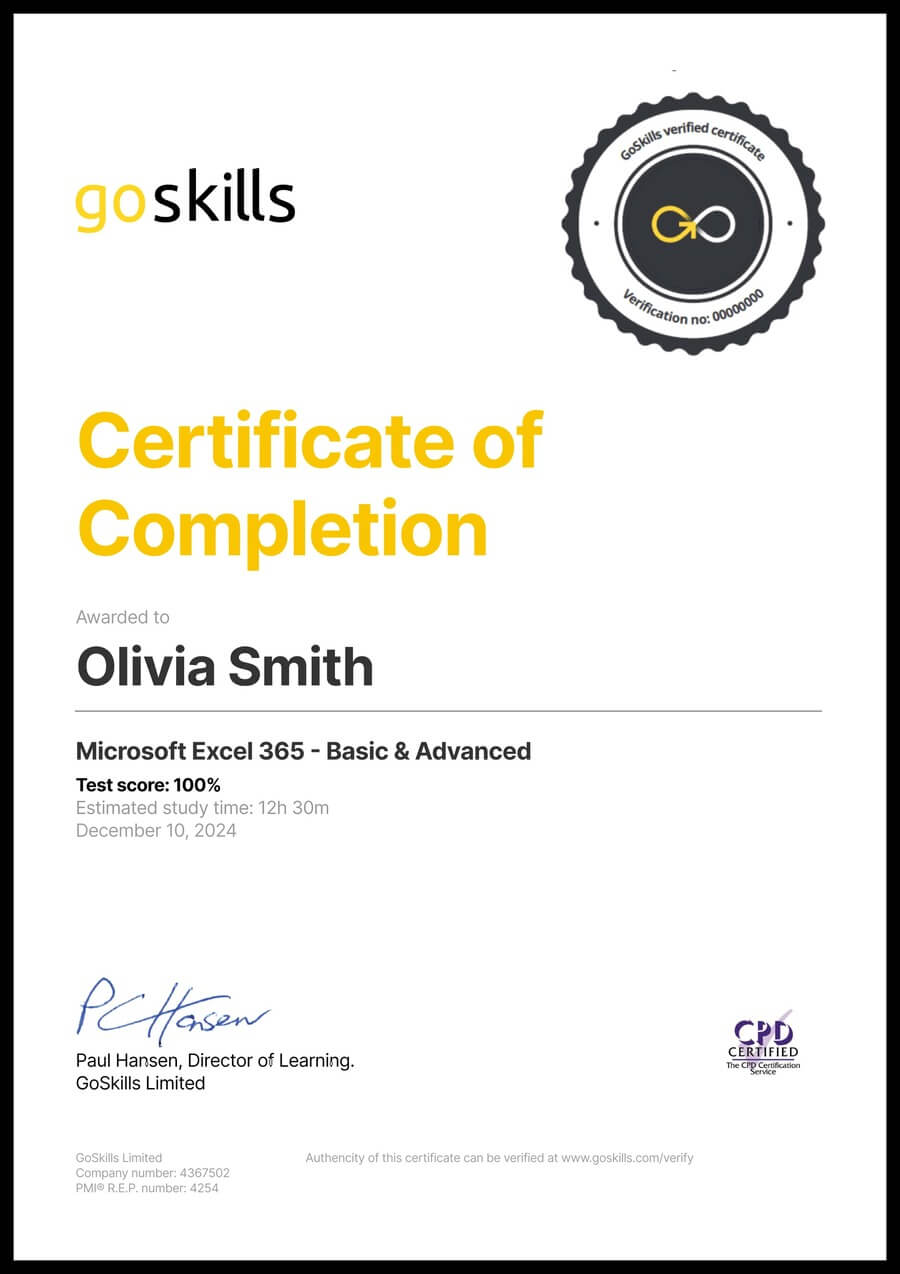Financial Modeling Training Online Course - GoSkills.com
Financial Modeling Basics
Financial modeling in Excel is extremely useful to forecast and make key decisions about your company's performance. This financial modeling training online is designed for beginners, to give you a solid foundation in the preparation needed before you build a financial model. You will learn the necessary concepts, functions and features required to structure and design your financial model to maximize usability and minimize risk. Examples are provided throughout the course so that you can apply the practical knowledge you learn through hands-on application in Excel.
Highlights:
- 55 practical tutorials.
- Understand the four key attributes of a good financial model.
- Useful Excel keyboard shortcuts to speed up your modeling.
- Layout tips to make your model easy to navigate through and understand.
- How to design your model to separate the inputs and calculations.
- The difference between formats and styles, and how to import styles into a workbook.
- How to effectively use number formatting and custom number formats.
- When and how to effectively apply conditional formatting.
- How to effectively assign and use range names, add hyperlinks and data validation.
- The importance of checks to keep your model error free.
- Printing and viewing tips, linking tips and security tips to protect your model.
- Key Excel functions that are essential to know when building a financial model.
Video tutorials are recorded in Microsoft Excel 2016 for PC. Learn more about how a GoSkills Excel certification can boost your career.
If you have mastered the basics and want to apply your knowledge to build a financial model, then check out the Financial Modeling Techniques course.
Want to be a more efficient Excel user? Start learning 200 of the best Excel shortcuts for PC and Mac.
Once enrolled, our friendly support team and tutors are here to help with any course related inquiries.
Syllabus
Download syllabus-
1
Separation of Inputs + Calculations How to design your model so that it separates the inputs and calculations. 6m
-
2
Workbook Structure Go over the elements that should be incorporated into a workbook. 4m
-
3
Layout Tips Part 3 General tips and options to change in Excel when laying out a typical worksheet in a financial model. 6m
-
4
Layout Tips Part 1 Layout tips can assist in building a financial model in Excel which is easy to navigate through and understand. 6m
-
5
Layout Tips Part 2 Layout tips for updating workbook names, adding hyperlinks, dates and freezing panes. 6m
-
6
Formats vs. Styles Highlight the difference between formats and styles in Excel, why they are important and when to apply them. 6m
-
7
Number Formatting Part 1 It is important how numerical data is presented in Excel. Learn how to effectively use number formatting. 4m
-
8
Number Formatting Part 2 Understand the coding in Custom Number Formatting. 3m
-
9
Conditional Formatting When to use conditional formatting, and how to effectively apply it. 6m
-
10
Layout Tips Part 6 How to use Work in Progress (WIP) Flagging. 4m
-
11
Keyboard Shortcuts A summary of Keyboard Shortcuts. 3m
-
12
Layout Tips Part 4 Layout Tips for using the RANDBETWEEN function to generate random numbers for testing and labelling units. 5m
-
13
Layout Tips Part 5 Formatting tips to improve the look and keep the layout of the template consistent. 5m
-
14
Formats vs. Styles Part 2 How to import styles into a workbook. 4m
-
15
Number Formatting Part 3 How to use Custom Number Formatting. 4m
-
16
Number Formatting Part 4 How to use Custom Number Formatting, continued. 4m
-
1
Range Names Part 1 How to effectively assign and use range names in an Excel worksheet. 5m
-
2
Range Names Part 2 How to use Range Names in a formula. 6m
-
3
Hyperlinks When and where to use hyperlinks to aid end user navigation. 5m
-
4
Overall Checks Highlight the situations where checks are useful, and how the different checks fit into 3 categories. Error Checks, Sensitivity Checks, and Alert Checks. 7m
-
5
Error Checks How to create a prima facie error check. 6m
-
6
Sensitivity Check How to create a sensitivity check and where to use one. 3m
-
7
Alert Checks The check that checks for everything else sensitivity and error checks don't. 4m
-
8
Data Validation Understand how to restrict what end users type into a cell using Data Validation, with examples of lists and whole numbers. 4m
-
9
Data Validation Part 2 Understand how to restrict what end users type into a cell using Data Validation, with examples of text length and custom validation. 3m
-
10
Range Names Part 3 How to use Range Names in a formula, continued. 5m
-
1
Printing and Viewing Tips The steps to take to ensure that the model looks as intended when printed. 7m
-
2
Linking Tips The proper habits to adopt when linking cells together, and the reasons why. 7m
-
3
Security and Protection The proper steps to take to protect the integrity of the model. 5m
-
4
Version Control The naming conventions to adopt and the habits that should be practiced. 3m
-
1
IF Illustration and issues with the IF function. 6m
-
2
SUMIF Illustration and issues with the SUMIF function. 8m
-
3
SUM Illustration and issues with the SUM function. 5m
-
4
SUMPRODUCT Illustration and issues with the SUMPRODUCT function. 6m
-
5
MATCH Illustration and issues with the MATCH function. 5m
-
6
MAX and MIN Illustration and issues with MAX and MIN. 5m
-
7
SUMIFS Illustration and issues with the SUMIFS function. 3m
-
8
OFFSET Illustration and issues with the OFFSET function. 7m
-
9
LOOKUP Illustration and issues with the LOOKUP function. 6m
-
10
LOOKUP Part 2 Illustration and issues with the LOOKUP function continued. 6m
-
11
Functions Overview An overview of the key functions used for financial modeling in Excel. 5m
-
12
SUMPRODUCT Part 2 An advanced example of the use of SUMPRODUCT. 5m
-
13
Don't Use HLOOKUP and VLOOKUP Why not to use HLOOKUP and VLOOKUP functions. 5m
-
14
INDEX Illustrations of the use of the INDEX function. 4m
-
15
INDEX MATCH Illustrations of the use of INDEX MATCH. 7m
-
16
OFFSET Part 2 Illustration and issues with the OFFSET function continued. 6m
-
17
OFFSET Part 3 A final look at the illustration and issues with the OFFSET function. 6m
-
18
MOD Illustrations and issues with the MOD function. 5m
-
19
EOMONTH Illustrations and issues with the EOMONTH function. 5m
-
20
Finale An overview of what we have covered in the Financial Modeling Basics course. 1m
Certificate
Certificate of Completion
Awarded upon successful completion of the course.

Instructor
Liam Bastick
Liam is a Fellow of the Institute of Chartered Accountants (ICAEW), a Fellow of the Institute of Chartered Management Accountants (CIMA), a Chartered Global Management Accountant (CGMA) and is also a professional mathematician.
Liam has over 30 years’ experience in financial model development and auditing, valuations, M&A, strategy, training and consultancy. He has considerable experience in many different sectors including banking, energy, media, mining, oil and gas, private equity, transport and utilities. He has worked with many internationally recognised clients, constructing and reviewing strategic, operational and valuation models for many high profile IPOs, LBOs and strategic assignments. This has taken him to many countries including Australia, Belgium, Denmark, France, Germany, Hong Kong, Indonesia, Malaysia, Netherlands, New Zealand, Switzerland, the United Kingdom, the United States and Vietnam.

Liam Bastick
Excel MVP
Accreditations
Link to awardsHow GoSkills helped Chris
I got the promotion largely because of the skills I could develop, thanks to the GoSkills courses I took. I set aside at least 30 minutes daily to invest in myself and my professional growth. Seeing how much this has helped me become a more efficient employee is a big motivation.


